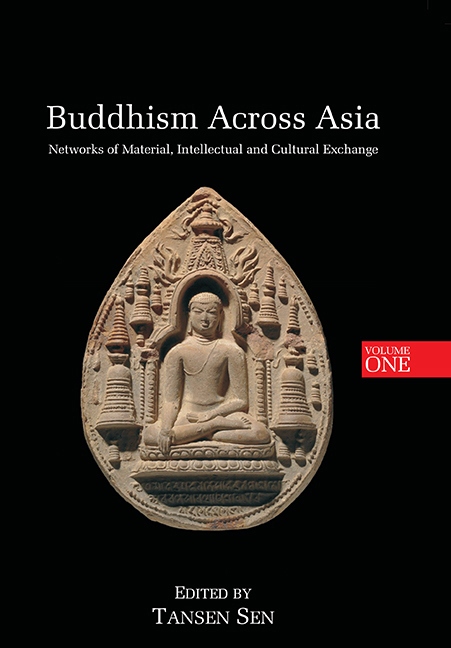Book contents
- Frontmatter
- Dedication
- Contents
- Introduction: Buddhism in Asian History
- Part I Tran smissions of Buddhism Before the Seventh Century
- Part II Buddhism Across Asia between the Seventh and Fifteenth Centuries
- 8 On Kuiji's Sanskrit Compound Analyses: Transmission of Sanskrit Grammar in the Early Tang Dynasty
- 9 Abridged Teaching (Lüe Jiao): Monastic Rules between India and China
- 10 From Nālandā to Chang'an: A Survey of Buddhist Libraries in Medieval China (618-907)
- 11 Multiple Traditions in One Ritual: A Reading of the Lantern-Lighting Prayers in Dunhuang Manuscripts
- 12 The Idea of India (Tenjiku) in Pre-Modern Japan: Issues of Signification and Representation in the Buddhist Translation of Cultures
- 13 The Buddhist Image Inside-Out: On the Placing of Objects Inside Statues in East Asia
- 14 Indian Abhidharma Literature in Tibet: A Study of the Vijñāna Section of Sthiramati's Pañcaskandhakavibhāṣā
- 15 From Aśoka to Jayavarman VII: Some Reflections on the Relationship between Buddhism and the State in India and Southeast Asia
- 16 The Theravāda Buddhist Ecumene in the Fifteenth Century: Intellectual Foundations and Material Representations
- Part III Buddhist Connections after the Fifteenth Century
- List of Contributors
- Index
- Miscellaneous Endmatter
14 - Indian Abhidharma Literature in Tibet: A Study of the Vijñāna Section of Sthiramati's Pañcaskandhakavibhāṣā
from Part II - Buddhism Across Asia between the Seventh and Fifteenth Centuries
Published online by Cambridge University Press: 21 October 2015
- Frontmatter
- Dedication
- Contents
- Introduction: Buddhism in Asian History
- Part I Tran smissions of Buddhism Before the Seventh Century
- Part II Buddhism Across Asia between the Seventh and Fifteenth Centuries
- 8 On Kuiji's Sanskrit Compound Analyses: Transmission of Sanskrit Grammar in the Early Tang Dynasty
- 9 Abridged Teaching (Lüe Jiao): Monastic Rules between India and China
- 10 From Nālandā to Chang'an: A Survey of Buddhist Libraries in Medieval China (618-907)
- 11 Multiple Traditions in One Ritual: A Reading of the Lantern-Lighting Prayers in Dunhuang Manuscripts
- 12 The Idea of India (Tenjiku) in Pre-Modern Japan: Issues of Signification and Representation in the Buddhist Translation of Cultures
- 13 The Buddhist Image Inside-Out: On the Placing of Objects Inside Statues in East Asia
- 14 Indian Abhidharma Literature in Tibet: A Study of the Vijñāna Section of Sthiramati's Pañcaskandhakavibhāṣā
- 15 From Aśoka to Jayavarman VII: Some Reflections on the Relationship between Buddhism and the State in India and Southeast Asia
- 16 The Theravāda Buddhist Ecumene in the Fifteenth Century: Intellectual Foundations and Material Representations
- Part III Buddhist Connections after the Fifteenth Century
- List of Contributors
- Index
- Miscellaneous Endmatter
Summary
INTRODUCTION
Most of the Indian Abhidharma texts available in Tibetan translation were produced in the ninth century by the Tibetan translators Ska ba dpal brtsegs, Ye shes sde, and Cog ro klu'i rgyal mtshan in collaboration with the Indian panditas Jinamitra, Śīlendrabodhi, Prajnāvarman, Dānaśīla, and Viśuddhisim{ ha. They prepared translations of the Abhidharmasamuccaya (P 5550) and its commentaries, the Abhidharmasamuccayabhāsya (P 5554) and the Abhidharmasamuccayavyākhyā (P 5555), of parts of the Prajnaptiśāstra (P 5587-5589), of the Abhidharmakośa(bhāsya) (P 5590 and 5591) and its commentary, the Sphutārthā Abhidharmakośavyākhyā (P 5593), of the Sārasamuccaya (P 5598), as well as of the Pancaskandhaka (P 5560) and its three commentaries, namely, Sthiramati's Pancaskandhakavibhāsā (P 5567), Gunaprabha's Pancaskandhavivarana (P 5568) and *Prthivībandhu's Pancaskandhabhāsya (P 5569). The latest translation of an Indian Abhidharma treatise into Tibetan was probably produced by the Tibetan grammarian and translator Chos skyong bzang po (1441-1527/28), also known by his Sanskrit name Dharmapālabhadra, who rendered into Tibetan Sthiramati's extensive commentary on the Abhidharmakośabhāsya, the Abhidharmakośabhāsyatīkā Tattvārthā (P 5875).
Despite the existence of a great variety of Abhidharma works in the Tibetan canon, only two of these texts made their way into the general curriculum of Tibetan monastic education and were transmitted in a continuous lineage: the Abhidharmakośa(bhāsya) and the Abhidharmasamuccaya. Remarkably, the teaching transmission of the Abhidharmasamuccaya is considered to have continued uninterruptedly from the ninth century, even through the “grey period” of Tibetan history (i.e. through post-imperial times from 842 until the end of the tenth century), while the Abhidharmakośabhāsya was reintroduced to Tibet by the Indian pandita Smrti in the late tenth century after a gap in the early transmission lineage.
Besides the Abhidharmasamuccaya, the Abhidharma of the Yogācāras is also represented in the Tibetan tradition by a collection of indigenous works that deal exclusively with the Yogācāra concepts of the “notion of ‘I’” (klistamanas, nyon mongs pa can gyi yid) and the “store mind” (ālayavijnāna, kun gzhi rnam par shes pa).
- Type
- Chapter
- Information
- Buddhism Across AsiaNetworks of Material, Intellectual and Cultural Exchange, volume 1, pp. 309 - 326Publisher: ISEAS–Yusof Ishak InstitutePrint publication year: 2014



